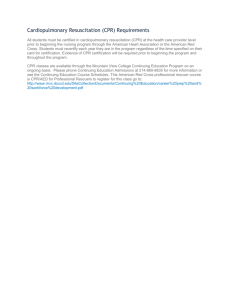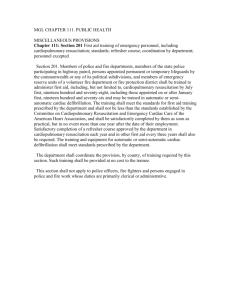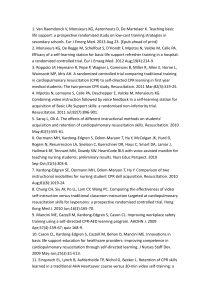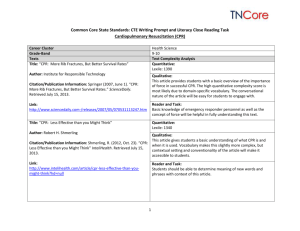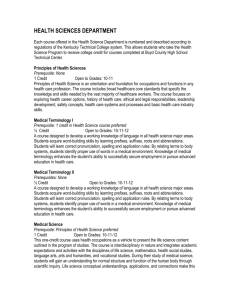An Act Relative to Medical Emergency Response Plans for Schools
advertisement
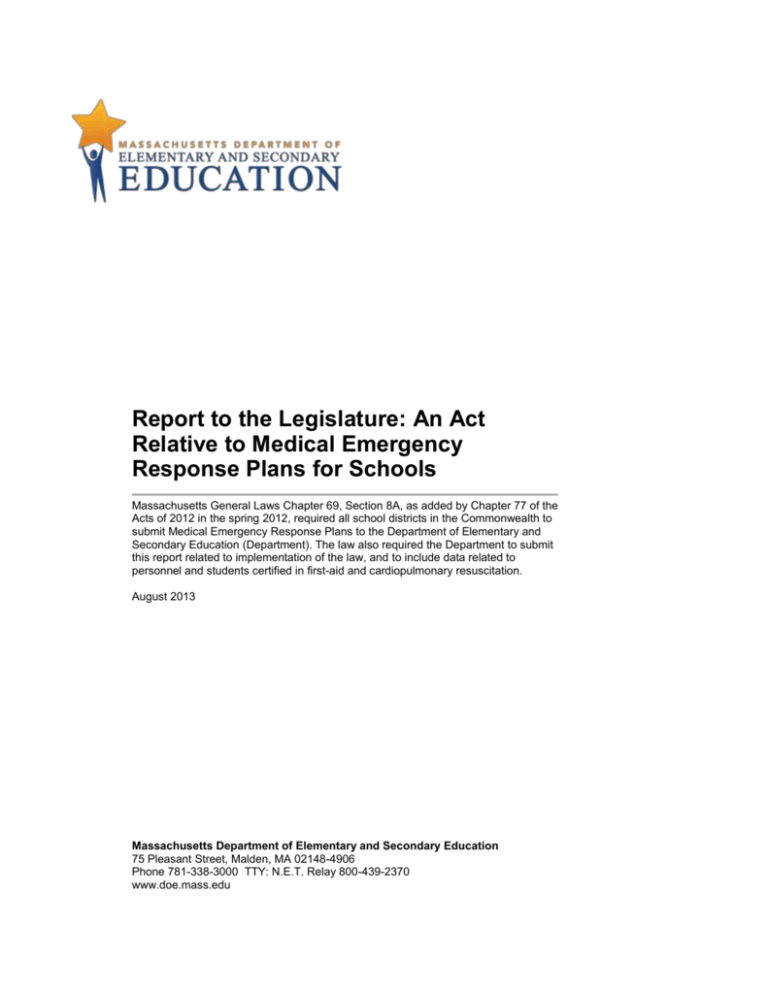
Report to the Legislature: An Act Relative to Medical Emergency Response Plans for Schools Massachusetts General Laws Chapter 69, Section 8A, as added by Chapter 77 of the Acts of 2012 in the spring 2012, required all school districts in the Commonwealth to submit Medical Emergency Response Plans to the Department of Elementary and Secondary Education (Department). The law also required the Department to submit this report related to implementation of the law, and to include data related to personnel and students certified in first-aid and cardiopulmonary resuscitation. August 2013 Massachusetts Department of Elementary and Secondary Education 75 Pleasant Street, Malden, MA 02148-4906 Phone 781-338-3000 TTY: N.E.T. Relay 800-439-2370 www.doe.mass.edu This document was prepared by the Massachusetts Department of Elementary and Secondary Education Mitchell D. Chester, Ed.D. Commissioner Board of Elementary and Secondary Education Members Ms. Maura Banta, Chair, Melrose Mr. Daniel Brogan, Chair, Student Advisory Council, Dennis Dr. Vanessa Calderón-Rosado, Milton Ms. Harneen Chernow, Jamaica Plain Ms. Karen Daniels, Milton Ms. Ruth Kaplan, Brookline Dr. Matthew Malone, Secretary of Education, Roslindale Dr. Pendred E. Noyce, Weston Mr. David Roach, Sutton Mitchell D. Chester, Ed.D., Commissioner and Secretary to the Board The Massachusetts Department of Elementary and Secondary Education, an affirmative action employer, is committed to ensuring that all of its programs and facilities are accessible to all members of the public. We do not discriminate on the basis of age, color, disability, national origin, race, religion, sex, gender identity, or sexual orientation. Inquiries regarding the Department’s compliance with Title IX and other civil rights laws may be directed to the Human Resources Director, 75 Pleasant St., Malden, MA 02148-4906. Phone: 781-338-6105. © 2012 Massachusetts Department of Elementary and Secondary Education Permission is hereby granted to copy any or all parts of this document for non-commercial educational purposes. Please credit the “Massachusetts Department of Elementary and Secondary Education.” This document printed on recycled paper Massachusetts Department of Elementary and Secondary Education 75 Pleasant Street, Malden, MA 02148-4906 Phone 781-338-3000 TTY: N.E.T. Relay 800-439-2370 www.doe.mass.edu Massachusetts Department of Elementary & Secondary Education 75 Pleasant Street, Malden, Massachusetts 02148-4906 Telephone: (781) 338-3000 TTY: N.E.T. Relay 1-800-439-2370 August 2013 Dear Members of the General Court, I am pleased to submit this Report to the Legislature: An Act Relative to Medical Emergency Response Plans for Schools pursuant to the Acts of 2012, Chapter 77, Section 2. In the spring of 2012, the Legislature passed and Governor Patrick signed into law this Act Relative to Medical Emergency Response Plans. Under the law, each school committee and Commonwealth charter school board of trustees shall ensure that every school under its jurisdiction has a written medical emergency response plan to reduce the incidence of lifethreatening emergencies and to promote efficient response to such emergencies. The plan shall be in addition to the multi-hazard evacuation plan required under section 363 of chapter 159 of the acts of 2000. As required by the law, Medical Emergency Response Plans were submitted by all districts for the more than 1,800 schools in the Commonwealth. Additionally, the law required that the Massachusetts Department of Elementary and Secondary Education (Department) submit a report to the legislature on or before July 1, 2013. As required, this report includes information regarding the implementation of this Act, the number of students and personnel certified in first-aid and cardiopulmonary resuscitation, and the number of schools that opt out of instruction in cardiopulmonary resuscitation under Section 1of Chapter 71 of the General Laws. If you have questions regarding this report, please feel free to contact me or Associate Commissioner John L.G. Bynoe III via jbynoe@doe.mass.edu or 781-338-6300. Sincerely, Mitchell D. Chester, Ed.D. Commissioner of Elementary and Secondary Education Table of Contents Introduction ................................................................................................................... 1 Medical Emergency Response Plans .......................................................................... 1 Implementation .............................................................................................................. 2 Required Data Collection .............................................................................................. 2 Appendix: An Act Relative to Medical Emergency Response Plans for Schools, Chapter 77, Acts of 2012............................................................................................... 4 Introduction The Department of Elementary and Secondary Education (Department) respectfully submits this Report to the Legislature: An Act Relative to Medical Emergency Response Plans for Schools pursuant to Chapter 77 of the Acts of 2012, Section 2: “The department of elementary and secondary education shall submit a report to the clerks of the senate and the house of representatives who shall forward the same to the house and senate chairs of the joint committee on education and the chairs of the house and senate committees on ways and means on the implementation of this act, the number of students and personnel certified in first-aid and cardio-pulmonary resuscitation and the number of schools that opt out of instruction in cardiopulmonary resuscitation under section 1 of chapter 71 of the General Laws, on or before July 1, 2013.” In the spring of 2012, the Legislature passed and Governor Patrick signed into law An Act Relative to Medical Emergency Response Plans for Schools. The Act amended Massachusetts General Laws, Chapter 69 by adding section 8A. Under the law, every school committee and charter school board of trustees must ensure that every school under its jurisdiction has a written Medical Emergency Response Plan. This new statute also requires this report to the legislature regarding the Act’s implementation and data on certification in first-aid and cardiopulmonary resuscitation. Medical Emergency Response Plans The Act requires that each school committee and commonwealth charter school board of trustees shall ensure that every school under its jurisdiction has a written medical emergency response plan to reduce the incidence of life-threatening emergencies and to promote efficient response to such emergencies. The plan shall be in addition to the multi-hazard evacuation plan required under section 363 of chapter 159 of the acts of 2000. The law requires that these plans be submitted to the Department once every three years, beginning on or before September 1, 2012. Each plan shall include: (1) a method for establishing a rapid communication system linking all parts of the school campus, including outdoor facilities and practice fields, to the emergency medical services system and protocols to clarify when the emergency medical services system and other emergency contact people shall be called; (2) a determination of emergency medical service response time to any location on campus; (3) a list of relevant contacts and telephone numbers with a protocol indicating when each person shall be called, including names of professionals to help with post-emergency support; (4) a method to efficiently direct emergency medical services personnel to any location on campus, including to the location of available rescue equipment; (5) safety precautions to prevent injuries in classrooms and on the facilities; 1 (6) a method of providing access to training in cardiopulmonary resuscitation and first aid for teachers, athletic coaches, trainers and other school staff, which may include training high school students in cardiopulmonary resuscitation; and (7) in the event the school possesses an automated external defibrillator, the location of the device, whether or not its location is either fixed or portable and those personnel who are trained in its use. Implementation During the spring and summer 2012, the Department provided all superintendents of schools and charter school leaders in the Commonwealth with information regarding this new Act and its requirements. As a part of this communication, the Department sent to all district leaders and posted on its Safe and Healthy Learning Environments website an August 2012 Memorandum detailing requirements for schools in the Medical Emergency Law. Included in the memorandum was a template for Medical Emergency Response Plans, a model Medical Emergency Response Plan, details of the law, information on Multi-Hazard Evacuation Plans, the process for submitting plans to the Department, and a Frequently Asked Questions document. Department staff tracked submissions, and also provided technical assistance and resources via phone to schools and school districts upon request. Medical Emergency Response Plans were submitted from the more than 1,800 schools in the Commonwealth. As required by the law, the model plan posted and sent to districts was developed in consultation with the Department of Public Health, and outlined a cost-neutral model Medical Emergency Response Plan in order to promote best practices. In developing the model plan, the Department referred to research prepared by the American Heart Association, the American Academy of Pediatrics, and other relevant organizations that identify the essential components of a medical emergency response plan. The Department will biennially update the model plan. Required Data Collection As noted in the introduction section, the law requires the Department to include in this report the number of students and personnel certified in first-aid and cardiopulmonary resuscitation and the number of schools that opt out of instruction in cardiopulmonary resuscitation (CPR). In spring 2013, the Department created a data collection survey tool and sent it to each school district leader in the Commonwealth, requesting information for the purpose of this report. Information compiled from this data collection survey is shown below. STAFF: CPR o More than 13,500 school personnel are trained in CPR. o The average percentage of school personnel trained in CPR was 22 percent. o The percentage of school personnel trained in CPR ranged from 0-98 percent. 2 FIRST AID o More than 8,700 school personnel are trained in First-Aid. o The average percentage of school personnel trained in First-Aid was 15 percent. o The percentage of school personnel trained in First-Aid ranged from 0-98 percent. STUDENTS: CPR o More than 25,900 students are trained in CPR. o The average percentage of students trained in CPR was 4 percent. o The percentage of students trained in CPR ranged from 0-76 percent. FIRST-AID o More than 15,700 students are trained in First-Aid. o The average percentage of students trained in First-Aid was 3 percent. o The percentage of students trained in First-Aid ranged from 0-76 percent. OPTING OUT OF INSTRUCTION IN CPR: 41 schools in 9 districts opted out of instruction in CPR. 3 Appendix: An Act Relative to Medical Emergency Response Plans for Schools, Chapter 77, Acts of 2012 Chapter 77, Acts of 2012: AN ACT RELATIVE TO MEDICAL EMERGENCY RESPONSE PLANS FOR SCHOOLS. Whereas, The deferred operation of this act would tend to defeat its purpose, which is to provide forthwith for emergency medical response plans in schools throughout the commonwealth, therefore it is hereby declared to be an emergency law, necessary for the immediate preservation of the public safety. Be it enacted by the Senate and House of Representatives in General Court assembled, and by the authority of the same as follows: SECTION 1. Chapter 69 of the General Laws is hereby amended by inserting after section 8 the following section:Section 8A. (a) Each school committee and commonwealth charter school board of trustees shall ensure that every school under its jurisdiction has a written medical emergency response plan to reduce the incidence of life-threatening emergencies and to promote efficient responses to such emergencies. The plan shall be in addition to the multi-hazard evacuation plan required under section 363 of chapter 159 of the acts of 2000. Each plan shall include: (1) a method for establishing a rapid communication system linking all parts of the school campus, including outdoor facilities and practice fields, to the emergency medical services system and protocols to clarify when the emergency medical services system and other emergency contact people shall be called; (2) a determination of emergency medical service response time to any location on campus; (3) a list of relevant contacts and telephone numbers with a protocol indicating when each person shall be called, including names of professionals to help with post-emergency support; (4) a method to efficiently direct emergency medical services personnel to any location on campus, including to the location of available rescue equipment; (5) safety precautions to prevent injuries in classrooms and on the facilities; (6) a method of providing access to training in cardiopulmonary resuscitation and first aid for teachers, athletic coaches, trainers and other school staff, which may include training high school students in cardiopulmonary resuscitation; and (7) in the event the school possesses an automated external defibrillator, the location of the device, whether or not its location is either fixed or portable and those personnel who are trained in its use. Plans shall be developed in consultation with the school nurse, school athletic team physicians, coaches, trainers and the local emergency medical services agency, as appropriate. Schools shall practice the response sequence at the beginning of each school year and periodically throughout 4 the year and evaluate and modify the plan as needed. Plans shall be submitted once every 3 years to the department of elementary and secondary education on or before September 1, beginning in the 2012-2013 school year. Plans shall be updated in the case of new construction or physical changes to the school campus. Included in each initial and subsequent filing of a medical emergency response plan, each school district shall report on the availability of automated external defibrillators in each school within the district, including, the total amount available in each school, the location of each within the school, whether or not the device is in a fixed location or is portable, those personnel or volunteers who are trained in its use, those personnel with access to the device during regular school hours and after and the total estimated amount of automated external defibrillators necessary to ensure campus-wide access during school hours, after-school activities and public events. (b) The department of elementary and secondary education, in consultation with the department of public health, shall develop a cost-neutral model medical emergency response plan in order to promote best practices. Said model plan shall be made available to school committees and commonwealth charter school boards. In developing the model plan, the department shall refer to research prepared by the American Heart Association, the American Academy of Pediatrics and other relevant organizations that identify the essential components of a medical emergency response plan. The department shall biennially update the model plan and post the plan on its website. SECTION 2. The department of elementary and secondary education shall submit a report to the clerks of the senate and the house of representatives who shall forward the same to the house and senate chairs of the joint committee on education and the chairs of the house and senate committees on ways and means on the implementation of this act, the number of students and personnel certified in first-aid and cardio-pulmonary resuscitation and the number of schools that opt out of instruction in cardiopulmonary resuscitation under section 1 of chapter 71 of the General Laws, on or before July 1, 2013. 5

